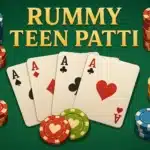Teen Patti Panaji
Welcome to Panaji’s Teen Patti, where the bustling city of Goa meets the excitement of one of India’s most popular card games. Teen Patti, located in the center of Panaji, Goa’s capital, is more than simply a game. This seaside city is defined by a blend of cultural experiences, tactics, strategies, and a laid-back appeal.
Ready to elevate your Teen Patti Panaji experience? Join us at Teen Patti Stars to get started!
Online Gaming in Panaji
Panaji, the capital of Goa, India, is a unique combination of history, culture, and modern appeal. Panaji, located along the gorgeous Mandovi River, is recognized for its colorful atmosphere, colonial architecture, and a unique combination of Indian and Portuguese influences.
Basic rules of Teen Patti Panaji
Teen Patti India is a popular card game in India, and its rules may differ somewhat based on local preferences and house regulations. Here are the fundamental rules of Teen Patti Panaji, a popular game in Panaji, Goa.
Objectives of Teen Patti Panaji
Teen Patti Panaji’s primary objective is to win chips or money from other players by having the best three-card hand at the table.
Players
Teen Patti Panaji typically plays with three to six players.
Setup
- Deck: A standard 52-card deck is used.
- Chips/Money: Players use chips or money for betting.
Card Ranking
The following are the card rankings (from highest to lowest):
- Trail or Set: Three cards with the same suit.
- Pure Sequence (Straight Flush): There are three similar outfits in a row.
- Sequence (Straight): It’s not the same suit, but three cards in a row.
- Color (Flush): Three cards of the same suit, not in any particular sequence.
- Pair: Two cards with the same suit.
- High Card: The person with the highest card who does not have any of the aforementioned will win the hand.
Betting Rounds
- Ante: The player places an initial “Ante” stake into the pot.
- Boot (Pot): As the player continues to wager, the pot grows larger.
- Blind: The player to the left of the dealer places a forced wager of “Small Blind,” while the player to the right places a forced bet of “Big Blind.”
- Dealing: Each participant will be dealt three cards face down.
- Betting Begins: Starting with the player on the dealer’s left, the player can wager or fold. The wager proceeds in a clockwise direction.
- Playing Blind: Players can pick blind games (without looking at their cards) with stakes equal to or higher than their present ones. In the blind game, the players’ cards stay face down until the conclusion.
Showdown
- Show or Pack: Following a betting round, the player might opt to show the card or wrap (fold).
- Winning Hand: The pot is won by the player with the better hands. When two players have identical hands, the player with the higher ranking card wins.
Variations of Teen Patti Panaji
Teen Patti Panaji is a flexible card game with several forms in India and beyond. Rules and variants may differ between areas and playing groupings. Here are some frequent Teen Patti Panaji variations:
|
Muflis or Lowball: The hand rankings are flipped in Muflis, and the aim is to have the lowest hand. The trail is the lowest hand, while the high card is the highest hand. |
|
Stud: In Stud Teen Patti Panaji, the player deals with all three cards at the same time, with no additional draws or replacements. |
|
Wild Card: Some variants can be utilized to finish a set or run by presenting the desired card as a wild card. |
|
Best of Four: Players will be dealt four cards and must pick the best three to form their hands. |
|
Three Straight: Players try to get three consecutive cards of the same suit. |
|
AK47: Using the A-K-4-7 card of any suit is considered a significant advantage in this version. |
|
Jumping the Pot: An ant, or stake, grows by a specified amount for each round that exceeds the can. |
|
No-Limit Betting: In this edition, there is no maximum bet restriction. Players can wager any amount they have in front of them. |
|
Community Cards: Some poker-inspired variations include community cards that are shared by all players to supplement a player’s hand. |
|
Joker: Some games include the Joker as a wild card that may be used to replace other cards. |
|
Four-Card Trick: Participants are given four cards and must create the finest three cards possible. The fourth card is not utilized to calculate the total number of cards. |
|
High Wild: One or more cards are marked as wild, and their ranking is susceptible to alter based on player preferences or house rules. |
|
Two Lives: The player begins with two tokens or lives. If a player loses one round, the game continues until the player loses two. |
|
Blind Pot Limit: This variation mixes blind games with pot marginal bets. Blind games are available, and maximum bets are limited to the current pot size. |
These modifications add intrigue and strategy to the game, and other groups may have their own set of rules. Before playing the Teen Patti Panaji game, it is vital to understand the unique rules and variants that are utilized to ensure that everyone feels the same way.
Teen Patti Star – Download install the app to play casino games and win tons of real cash!
Big Agent Plan – Unlock exclusive rewards, earn massive commissions, and grow your gaming network like never before.
FAQs

Teen Patti Brands
Dhani Teen Patti — Your Card Adventure with Dhani
Exploring the World of Teen Patti Live
Happy Ace Casino | Teen Patti Stars
Happy Teen Patti — The Joyful Realm of Card Gaming
Meta Teen Patti | Teen Patti Stars
Real Teen Patti — Embark on a Card Gaming Journey
Rummy Ares APK | Teen Patti Stars
Rummy East APK | Teen Patti Stars
Rummy Master | Teen Patti Stars
Rummy Perfect | Teen Patti Stars
Slot Master APK | Teen Patti Stars
Teen Patti Circle | Teen Patti Stars
Teen Patti Club – A pass to Card Game Excellence
Teen Patti Glee – The Delight of Card Gaming
Teen Patti Gold | Teen Patti Stars
Teen Patti Live | Teen Patti Stars
Teen Patti Master | Teen Patti Stars
Teen Patti Octro | Teen Patti Stars
Teen Patti Sweet — Unleash Sweetness in Every Hand
Teen Patti Vungo | Teen Patti Stars
Teen Patti Winner — Unlocking Victory
Teen Patti Yes – Igniting Your Passion for Card Gaming
Read Our Blogs
- Maximizing Slot Bonuses: Your Guide to Free Spins Promotions in 2025Free spins promotions are a cornerstone of online casino gaming, offering players a chance to spin the reels of top slot games without risking their own money. In 2025, these bonuses have evolved, with casinos offering innovative, player-friendly deals that enhance gameplay and boost winning potential. Whether you’re a novice or a seasoned slot enthusiast,…
- The Ultimate Guide to the Top 10 Online Casinos with Stellar Bonus Promotions in 2025In the ever-evolving world of online gambling, 2025 has ushered in a new era of exciting bonus promotions that enhance the gaming experience for players worldwide. With countless platforms vying for attention, finding casinos with the best bonuses can be a game-changer for both new and seasoned players. This comprehensive guide explores the top 10…
- The Future of Online Gaming in India: Trends and Innovations for 2026Introduction to India’s Online Gaming Revolution India’s online gaming industry is on the cusp of a transformative era, with 2026 poised to redefine how millions engage with digital entertainment. From culturally resonant games like Teen Patti to cutting-edge slots and live dealer experiences, platforms like Teen Patti Stars are driving innovation. This 3500-word guide explores…
- Discovering the Thrill of Rummy Teen Patti at Teen Patti StarsIgniting India’s Card Game Passion on Teen Patti Stars Rummy Teen Patti, beloved staples of Indian card gaming, bring strategy, skill, and camaraderie to life, captivating players across generations. On Teen Patti Stars, a dynamic platform launched in 2023, these games flourish in a digital realm tailored for Indian enthusiasts. Offering Return to Player (RTP)…
- Unveiling the Mechanics of Slot Games on Teen Patti StarsDiving into the World of Slots at Teen Patti Stars Slot games have become a cornerstone of online gaming in India, offering a whirlwind of vibrant visuals, thrilling mechanics, and the promise of substantial rewards. At Teen Patti Stars, a premier platform launched in 2023, slots deliver an immersive experience tailored for Indian players, featuring…
- Is Teen Patti Game Legit or Fake? My Deep Dive into the World of Online 3 PattiThe Night I Questioned Teen Patti’s Legitimacy It was a humid Mumbai evening, and I was chilling with friends over chai when someone mentioned playing Teen Patti online for real cash. As a fan of the card game from Diwali nights, I was intrigued but skeptical. Could a digital version of India’s beloved “Indian Poker”…
- Roulette Teen Patti: A Fusion of Tradition, Thrill, and Trust in Online GamingThe online gaming landscape in India has witnessed a remarkable evolution, blending traditional card games with modern innovations to captivate a diverse audience. Among these, Roulette Teen Patti stands out as a thrilling hybrid that merges the cultural charm of Teen Patti—a beloved Indian card game—with the fast-paced excitement of roulette. This unique game, offered…
- Rummy Teen Patti: The Ultimate Guide to Two Iconic Card GamesIndia’s love for card games is timeless, with Rummy and Teen Patti reigning as two of the most cherished pastimes. These games, deeply embedded in the country’s cultural fabric, have transitioned from festive gatherings to vibrant online platforms, captivating millions with their blend of strategy, skill, and excitement. Whether you’re a beginner eager to learn…
- Why Jhandi Munda Is More Than Just a Festival GameJhandi Munda, a traditional Indian dice game, has long been a staple of festive gatherings, from the vibrant celebrations of Dashain and Tihar to casual street-side play in India’s Northeast. But to dismiss it as merely a festival game is to overlook its rich cultural significance, strategic depth, and modern evolution into a global online…
- Crash Teen Patti: Your Ticket to Thrills, Strategy, and Epic WinsCrash Teen Patti is a modern adaptation of the traditional Indian card game Teen Patti, often referred to as Indian Poker. While the classic version revolves around forming the best three-card hand, Crash Teen Patti shifts the focus to a multiplier-based betting system inspired by crash gambling games. Players place wagers on a multiplier that…










